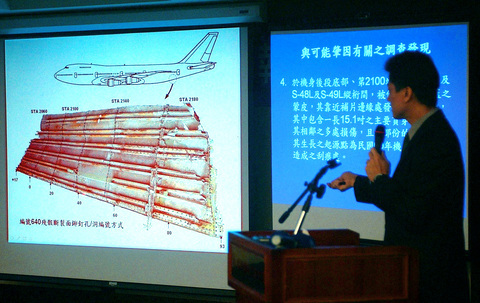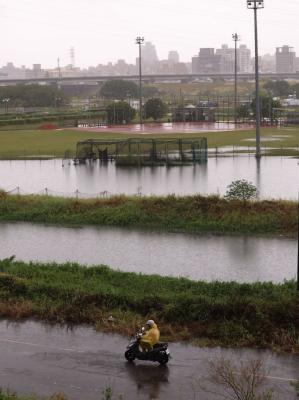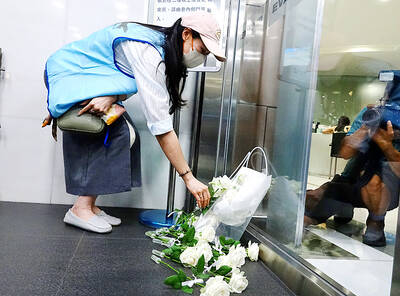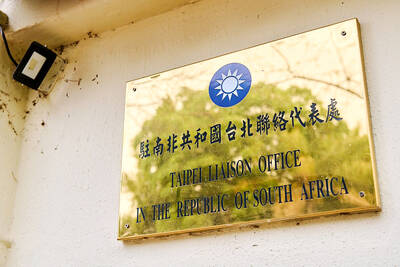The Aviation Safety Counsel (ASC) yesterday published its findings in a report on the China Airlines plane that broke into pieces over the sea between Taiwan and Hong Kong in May 2002. The report blamed cracks in the plane's fuselage, as well as poor maintenance as the cause of the crash that killed all 225 passengers on board.
On May 25, 2002, the CAL flight CI-611, a Boeing 747-200 jumbo jet, broke apart and plunged into the Taiwan Strait 23 nautical miles northeast of Penghu County shortly after takeoff from CKS International Airport.

PHOTO: CNA
After more than two years of analyzing information gathered from the plane's flight data recorder, air traffic control, wreckage distribution and a reconstructed section of the fuselage, the ASC concluded that a 180.34cm crack on the fuselage resulted in the in-flight breakup at the altitude of 10,668m, killing 206 passengers and 19 crew members.
According to the ASC, the fatigue crack in the aircraft could be dated back to an accident that took place 25 years ago. On Feb. 7, 1980, the aircraft suffered damage when its tail touched the ground while landing in Hong Kong. Although the damaged plane was shipped back to Taiwan and underwent temporary repairs the day after the incident, permanent repairs conducted by the nation's largest carrier, China Airlines, were flawed.
"China Airlines did not repair the [damage] in accordance with Boeing's [structural repair manual]. The damaged skin should have been either trimmed or removed as the standard procedure required. But the repairs did not extend sufficiently beyond the damaged area and thus, did not restore structural strength," said ASC Chairman Kay Yong (
The ASC believes that the pre-existing fissures on scratched surface, and after not having been properly fixed, deepened and grew to a 180.34cm crack as a result of pressurization and de-pressurization during flights.
"A crack measuring 180.34cm in length is long enough to cause structural separation in the fuselage. It is the root cause of the in-flight breakup of the aircraft," said Thomas Wang (王興中) head of the ASC's investigation team.
Although the ASC could not confirm exactly when the fuselage came apart, the Cabinet-level aviation authority criticized the air carrier for not finding the damage to the aging aircraft in regular checkups over the past 25 years.
CAL officials, however, rebuked the ASC's report and questioned its findings.
"Since the section of the aircraft that is suspected of causing the crash was not found, the information is not conclusive enough to determine the exact cause of the accident," CAL said in a statement.
"The ASC said that they have found 75 percent of the aircraft, but they actually collected only 50 percent of the damaged section 46, the key part needed to determine the cause of the crash," said CAL spokesman Roger Hen (
While openly disputing the ASC's findings, the air carrier objected to the claim that maintenance oversight was also to blame.
"Our checkups are conducted in compliance with the SRM [structural repair manual]. Boeing stated clearly that if repairs are done in accordance with the SRM, there is no need to report it to the aircraft manufacturer," Hen said.
According to the regulations of Boeing's Repair Assessment Program, aircraft should have undergone inspections upon reaching of 22,000 flights. Yet the accident occurred when the jet completed its 21,398th flight, a few times of landing and take-off away from the maintenance program's maximum threshold.
Civil Aeronautics Administration (CAA) slammed that the ASC's report, accusing the agency of failing to find the actual cause of the crash.
"How could the ASC jump hastily its conclusions when half of the [section in question] has yet to be found?" said CAA director-general Billy Chang (張國政).

Taipei, New Taipei City, Keelung and Taoyuan would issue a decision at 8pm on whether to cancel work and school tomorrow due to forecasted heavy rain, Keelung Mayor Hsieh Kuo-liang (謝國樑) said today. Hsieh told reporters that absent some pressing reason, the four northern cities would announce the decision jointly at 8pm. Keelung is expected to receive between 300mm and 490mm of rain in the period from 2pm today through 2pm tomorrow, Central Weather Administration data showed. Keelung City Government regulations stipulate that school and work can be canceled if rain totals in mountainous or low-elevation areas are forecast to exceed 350mm in

EVA Airways president Sun Chia-ming (孫嘉明) and other senior executives yesterday bowed in apology over the death of a flight attendant, saying the company has begun improving its health-reporting, review and work coordination mechanisms. “We promise to handle this matter with the utmost responsibility to ensure safer and healthier working conditions for all EVA Air employees,” Sun said. The flight attendant, a woman surnamed Sun (孫), died on Friday last week of undisclosed causes shortly after returning from a work assignment in Milan, Italy, the airline said. Chinese-language media reported that the woman fell ill working on a Taipei-to-Milan flight on Sept. 22

COUNTERMEASURE: Taiwan was to implement controls for 47 tech products bound for South Africa after the latter downgraded and renamed Taipei’s ‘de facto’ offices The Ministry of Foreign Affairs is still reviewing a new agreement proposed by the South African government last month to regulate the status of reciprocal representative offices, Minister of Foreign Affairs Lin Chia-lung (林佳龍) said yesterday. Asked about the latest developments in a year-long controversy over Taiwan’s de facto representative office in South Africa, Lin during a legislative session said that the ministry was consulting with legal experts on the proposed new agreement. While the new proposal offers Taiwan greater flexibility, the ministry does not find it acceptable, Lin said without elaborating. The ministry is still open to resuming retaliatory measures against South

1.4nm WAFERS: While TSMC is gearing up to expand its overseas production, it would also continue to invest in Taiwan, company chairman and CEO C.C. Wei said Taiwan Semiconductor Manufacturing Co (TSMC) has applied for permission to construct a new plant in the Central Taiwan Science Park (中部科學園區), which it would use for the production of new high-speed wafers, the National Science and Technology Council said yesterday. The council, which supervises three major science parks in Taiwan, confirmed that the Central Taiwan Science Park Bureau had received an application on Friday from TSMC, the world’s largest contract chipmaker, to commence work on the new A14 fab. A14 technology, a 1.4 nanometer (nm) process, is designed to drive artificial intelligence transformation by enabling faster computing and greater power